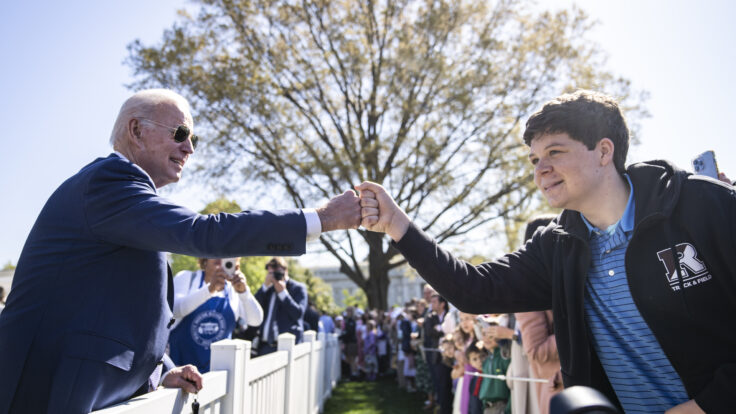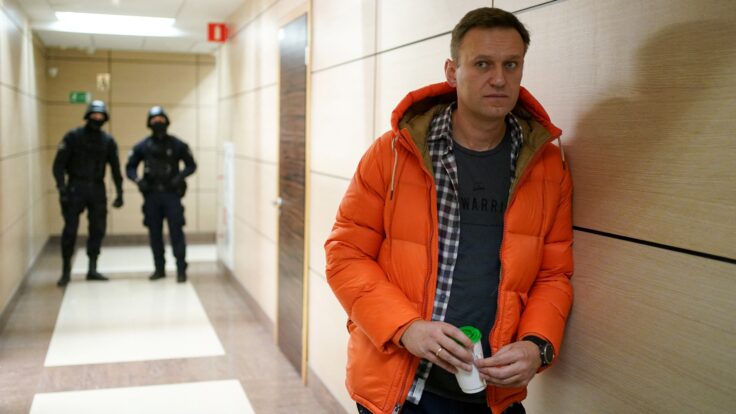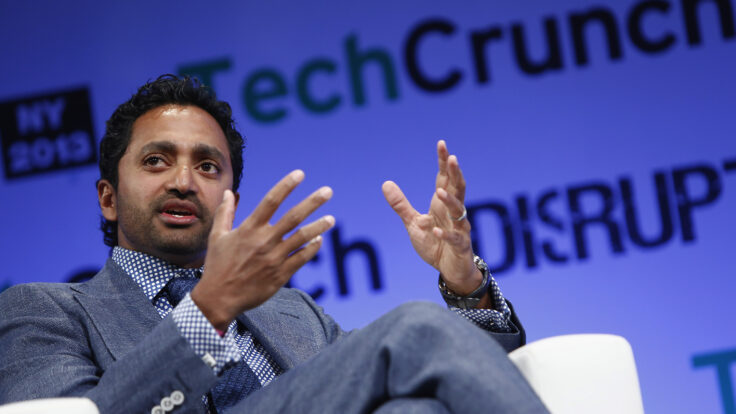Hello, and welcome back to The Best & The Brightest. I’m Julia Ioffe and it’s
foreign policy Thursday.
Between the I.M.F./World Bank spring meetings and the upcoming White House Correspondents’ Association Dinner, the city is an absolute disaster right now. But if you are out and about this weekend, at the dinner or some of the side parties, come by and say hi. I’ll be there, as will Abby, Peter, Leigh Ann, and Dylan. We’d love to see you!
Today, news and notes on Marco
Rubio’s maybe not-so-radical State Department re-org. But first, a word about the Ukraine-Russia peace negotiations…
|
- Putin’s
indecent proposal: Having been temporarily distracted trying to send the American economy back to the 19th century, Donald Trump is again interested in ending a conflict he previously promised to solve within 24 hours. Not coincidentally, next week marks the end of Trump’s first 100 days, and he seems to
badly want a “mission accomplished” moment.
Steve Witkoff, Trump’s indispensable man and Vladimir Putin’s useful idiot, recently brought back a proposal from Moscow: Russia would graciously give up some claims to the four Ukrainian regions it annexed in September 2022, but still doesn’t fully control, in exchange for U.S.
recognition of Crimea as Russian territory, the lifting of sanctions on Russia, and preventing Ukraine from joining NATO. Yesterday, the Trump administration abruptly pulled out of European-sponsored peace talks and followed up with a proposal similar to the Russian deal.
Volodymyr Zelensky cited the Ukrainian constitution as prohibiting such concessions. Though, as others have
noted, it is not just Ukrainian law that stands in the way. U.S. law also forbids recognizing seized Ukrainian territory as
Russian—thanks to one Senator Marco Rubio. Right on cue, Trump slammed Zelensky, saying it was
the Ukrainian leader who “makes it so difficult to settle this war.”
- Zelensky’s costly waiting game: For the past two months, as I’ve written, the Ukrainian strategy has been to mollify Trump by saying yes as often as possible in order to buy time—time for Putin to bite Trump, and for Trump to finally
realize that Putin doesn’t really want peace. For the past two days, we’ve seen this play out rather vividly. Putin offered something that sounded reasonable to Trump, knowing full well that he was putting Zelensky in a bind: Zelensky could not possibly say yes and survive politically at home, and he couldn’t say no without earning Trump’s ire. Which is exactly what happened.
Until, that is, Putin unleashed a barrage of drones and missiles on the Ukrainian capital,
killing a dozen civilians. Russian missiles had been battering civilian areas all over Ukraine with a compounded viciousness for weeks, murdering dozens, including many children, but that was before Trump was paying attention and trying to get a deal done on deadline. Waking up to the news, Trump fired off an angry Truth Social post. “I am not happy with the Russian strikes on KYIV,” he wrote. “Not necessary, and very bad timing. Vladimir, STOP! 5000 soldiers a week are dying. Lets get the Peace Deal DONE!”
It’s unclear whether this anger will change Trump’s approach to the negotiations, which has been to give Russia everything it asks for. (Art of the deal!) But for now, it’s a win—albeit a costly one—for Zelensky. The best the Ukrainians can hope for, in my opinion, is that Trump again gets distracted or, once the 100-day marker passes with no
ceasefire, loses interest. Given remarks by Rubio and J.D. Vance that the U.S. is ready to walk away from the negotiations, it seems likely that will happen.
Think about it this way: Zelensky doesn’t want a bad deal, Putin doesn’t want a good deal, and Trump just wants any deal. But if neither Kyiv nor Moscow will give him the easy win—if they just want to tie him up at the negotiating table for months or even years—why should Trump keep wasting political
capital? Given the president’s notoriously short attention span, it’s hard to imagine that he will.
|
|
|
A MESSAGE FROM OUR SPONSOR
|
President Trump wants to put America First, but Big Pharma is putting America last. For too long, the pharmaceutical
industry has ripped off American patients – charging them over 3x more than consumers in other wealthy countries, even for the exact same drugs. The time for reform is now.
Learn more.
|
|
|
And now, a brief word from Abby…
|
|
|

|
Abby Livingston
|
|
With Senate Democratic circles buzzing about who will succeed Dick Durbin as party whip,
several Hill sources tell me Brian Schatz and Amy Klobuchar are considered the most serious contenders. Both senators have been busy donors to colleagues, according to last cycle’s campaign finance reports—not a bad seed-planting exercise ahead of a potential leadership race. But whoever winds up succeeding Durbin will shoulder an even heavier burden of campaign responsibilities.
Based on the F.E.C. database, at least, Klobuchar has been the significantly
more active of the two. F.E.C. reports show that Durbin raised $80,000 for the Democratic Senatorial Campaign Committee (D.S.C.C.) and channeled an additional $100,000 to Democratic incumbents and candidates last cycle. Klobuchar, meanwhile, gave $635,000 to the committee and donated $135,000 toward competitive campaigns, including to Tammy Baldwin, Lisa Blunt Rochester, Martin Heinrich, Mazie Hirono, Ruben Gallego, Tim
Kaine, Angus King, the Democratic Party of Nevada (essentially a donation toward Jacky Rosen’s reelection), Elissa Slotkin, and fellow Minnesotan Angie Craig, who is seriously considering a run for retiring Sen. Tina Smith’s seat. Meanwhile, Schatz donated $80,000 to the committee and cut checks worth a total of $95,000 to in-cycle Sens. Blunt Rochester, Gallego, Kirsten Gillibrand, Hirono, Kaine, Andy Kim, King, Klobuchar (!), Rosen, Slotkin, and Sheldon Whitehouse.
Senators also make plenty of moves that are not trackable in campaign finance records (but are most definitely monitored internally) in order to elect candidates—e.g.,
splitting money with the committee in fundraising emails, doing call time directly for the D.S.C.C., and hosting and attending fundraisers for colleagues. It’s still early days for the current cycle, and neither Schatz nor Klobuchar have donated to the committee, colleagues, or candidates yet. If this evolves into a protracted leadership contest, though, you can expect a fundraising arms race.
|
|
|
A draft executive order that would have gutted the State Department turned out to be, in
Secretary Marco Rubio’s words, “fake news.” But a reorganization is coming, and no one is quite sure what it means.
|
|
|
All last weekend, Staties past and present hyperventilated over a PDF bouncing around Washington: a
16-page draft of an executive order that would radically transform the State Department. The document was breathtaking in its sweep and vindictiveness: The two bureaus overseeing democracy, human rights, labor, and refugees would be entirely eliminated, as would the Office of Global Criminal Justice and the special envoy for climate, John Kerry’s old
position. The American embassy in Ottawa would be reduced to “no more than 10 consular officers.” Much of the U.S. diplomatic presence in sub-Saharan Africa would be narrowed to focus on counterterrorism, monitoring contagion, and the “strategic extraction and trade of critical natural resources”—an entire continent written off as nothing but a cauldron of violence and disease to be pillaged for raw materials.
If that weren’t enough, the draft executive order proposed to completely upend
the way foreign service officers are selected, trained, and dispatched to represent America abroad. The suggested changes would have transformed America’s diplomatic corp from well-educated generalists, who travel from one global post to the next, into one whose members pick a single region and language when applying to the foreign service and stick with it until they retire decades later. Then there was the draft’s requirement that a White House representative attend every single selection
interview “to ensure the candidate’s alignment with Administration priorities”—a commissar to screen all incoming future diplomats for loyalty to Donald Trump.
It was a stunning document, but no one could really say whether it would be implemented or where it originated. Was it going to become an executive order, as its title claimed? Or was it, as some Staties frantically hoped, part of an internal negotiation with DOGE? All weekend, people who had dedicated their lives
to the cause of American diplomacy grieved—only to discover, on Tuesday, that the draft E.O. was, as Secretary of State Marco Rubio had insisted, “fake news.”
|
|
|
A MESSAGE FROM OUR SPONSOR
|
Americans know who to blame for rising drug prices: Big Pharma. Most Republicans, Democrats, & Independents all
believe Big Pharma is stealing from Americans, one prescription at a time. Let’s hold them accountable and put Americans first.
Learn more.
|
|
|
The plan Rubio actually
announced this week would cut the headcount at Foggy Bottom by only 15 percent, not the 30 percent that had been rumored. According to the new document that was circulated, the re-org wouldn’t kill as many bureaus as the draft E.O.,
and would shuffle around some State offices into different verticals. Human rights and aid initiatives like the Bureau of Democracy, Human Rights, and Labor would survive, as would the State Department’s presence in Africa. They would just answer to different department masters.
Suddenly, things didn’t seem quite so dire. “A 15 percent cut could be manageable,” one former senior State official told me. “It depends on who they cut and how they do it.” The new document was, as a second
former senior State Department official put it, a “nothing-burger re-org plan, which was way less than expected.” Even Rubio’s rhetoric about left-wing radicals and “a State Department that stifles creativity, lacks accountability, and occasionally veers into outright hostility to American interests” seemed tolerable. “It’s not like that story that was going around over the weekend,” said Daniel Fried, a retired senior State official who is considered a giant of the institution.
“People were convinced it was accurate. A lot of people were spun up. But if this is where we end up, okay.”
It all felt a lot like the whiplash of Trump’s trade war: a completely insane opening bid (double-digit tariffs on everything from everywhere) that shocked the markets, followed by backpedaling to a comparatively more palatable position. Under any other conditions, it’d be as hard to imagine Staties celebrating a 15 percent staffing cut as it would be to imagine markets rallying on
news of a universal 10 percent tariff. But compared to the alternative—lobotomizing the department and instituting a MAGA audition process for aspiring diplomats—this seemed downright wonderful.
|
The relief was short-lived in both cases: There is still a full-blown trade war to manage, and the Trump
administration is still dedicated to making the State Department irrelevant. Yes, that process has been underway for the better part of two decades, under multiple administrations. But as one senior State Department veteran put it, this White House wants to see the department pared down even more, almost exclusively to its consular functions—“to keep people from coming to this country and to help people replace lost passports.”
Now, State Department staff and alumni are trying to make
sense of what the reorganization plan actually entails and what the hell just happened. One prevalent hypothesis is that the draft E.O. was the work of Pete Marocco, who had overseen the drawing and quartering of USAID, and that the document had been leaked by one of his opponents in order to sink it. (In a rare act of courage, Rubio fired Marocco last week.) “What ‘draft EO?’” Deputy White House Press Secretary Anna Kelly responded when I asked for clarification. “This was debunked as a fake document days ago and is unrelated to Secretary Rubio’s excellent plan to make the State Department more efficient. No one knows or cares where it came from except for ‘reporters’ desperate for a scoop.”
As for the re-org itself, the verdict is, unsurprisingly, mixed. The canard on
the right is that deep state bureaucrats at Foggy Bottom want to keep the bureaucracy exactly as it is, that they practically worship process. That is, you’ll be shocked to learn, not true. Staties love complaining about the inefficiencies and turf wars of the institution. They have lots of ideas for how to make it better.
Which is why several State Department alums support some of the Rubio reforms, such as culling the so-called “S family,” the special envoys who report directly
to the secretary. In the past, these offices specialized in everything from women’s issues to climate and technology. Career people were often frustrated that these higher-profile political appointees duplicated their functions and infringed on their territory, because every country has, well, women, and also climate and technology.
|
|
|
Others are not sad to see the J family—the old home of D.R.L., and refugee and other humanitarian matters—be
subordinated to a new office of the Coordinator for Foreign Assistance and Humanitarian Affairs. Like the S family, the J family of “functional” bureaus also often infringed on the domains of various regional desks. For example, a human rights issue in China would obviously involve the China desk, but also the human rights people. Who gets dibs? And what’s more important to shaping our policy toward China: its human rights violations or our economic and security concerns?
Rubio’s re-org
would resolve that question by placing more emphasis on region-specific interests. “We need to be grown-ups about how we talk about this,” he told Bari Weiss on her podcast. “Promoting democracy and human rights … with some country in the Middle East is going to look different than it would with some country in Central America or South America.”
|
As for the embassy and consulate closures, there are plenty of Staties who agree that some consulates should
have been closed ages ago—but in Western Europe, not in Africa. “Why do we have a consulate in Leipzig?” asked Eric Rubin, a retired career foreign service officer who, until recently, was the president of the foreign service union. “It made sense after reunification and we wanted to be on the ground, but that was before the internet and high-speed trains. Now it’s an hour from Berlin. Why do we have a consulate in a 14th-century palace in Florence that we bought for $25,000 after
World War II? Other than that it’s a 14th century palace and members of Congress and spouses love to go and be hosted there.”
But while Rubin and other former senior statespeople I spoke to think a lot of these closures are overdue in theory, they don’t believe they will save much money in practice. In fact, there is wide agreement that little of what has been proposed will meaningfully cut costs at the department. (Rubio admitted as much to Weiss, saying, “This is not a cost-cutting
exercise, although it certainly will provide savings to the American taxpayer. This is a policy exercise.”)
After all, it may sound reasonable to just have one diplomatic hub that handles all of the countries in West Africa, but how would American diplomats get around among the countries in their portfolio when there are few if any flights connecting all these small nations to each other? Would they have to spend days on travel, connecting in Johannesburg or Addis Ababa? “It’s not like
they’re going to give them a plane,” quipped the first former senior State official.
Alas, State Department people can only speculate. Aside from the re-org chart, which is now on the department’s website, along with a very general fact sheet and a brief and fiery statement from Rubio (widely believed to have been written in the White House),
the transformation of Foggy Bottom is very short on specifics. There are top-line numbers for office closures, but no information on which offices will be closed; for the number of staff that will be cut, but not how the cuts will be determined. As multiple sources told me this week, “the devil will be in the details.” There is a sense, at least among some, that this was all theater—that the real point of the blistering statement was about radical State Department staffers infected with
the woke mind virus working to undermine the president’s agenda, not the actual re-org. “It’s almost like the rhetoric was so aggressive as if to give cover for a reorganization that was not that radical,” said Fried.
Others, however, are far from reassured that the worst is over. The promised layoffs have yet to arrive, and embassies and consulates have not yet closed. The career foreign service and civilian staff are terrified and often act, Fried told me, as if they’re being monitored.
So far, the administration hasn’t nominated a single career foreign service officer to an ambassadorial post and, according to one source, they are not planning to do so. This would leave a lot of the far more difficult and less glamorous posts unstaffed. What political donor, for instance, wants to be ambassador to Djibouti?
But all of the tumult—unstaffed embassies, petrified diplomats—seems like the point. After all, of what use is a department that leans left, or that consists of
people claiming to be apolitical patriots, when Trump wants only partisan loyalists? Who needs professional diplomats, or even a Secretary of State, when you have Steve Witkoff acting as the ambassador for the master dealmaker himself? Rubio might be trying to reform the department, but is his boss? As Rubin put it, referring to the White House: “They don’t want things to work better, they want to destroy them.”
|
That’s all from me, friends. Come say hi if you see me this weekend. Otherwise, I’ll see
you back here next week. Until then, good night. Tomorrow will be worse.
Julia
|
|
|
Join Emmy Award-winning journalist Peter Hamby, along with the team of expert journalists at Puck, as they let you in on the
conversations insiders are having across the four corners of power in America: Wall Street, Washington, Silicon Valley, and Hollywood. Presented in partnership with Audacy, new episodes publish daily, Monday through Friday.
|
|
|
Unique and privileged insight into the private conversations taking place inside boardrooms and corner offices up and down Wall
Street, relayed by best-selling author, journalist, and former M&A senior banker William D. Cohan.
|
|
|
Need help? Review our FAQ page or contact us for assistance. For brand partnerships, email ads@puck.news.
You received this email because you signed up to receive emails from Puck, or as part of your Puck account associated with . To stop receiving this newsletter and/or manage all your email preferences,
click here.
|
Puck is published by Heat Media LLC. 107 Greenwich St, New York, NY 10006
|
|
|
|






















